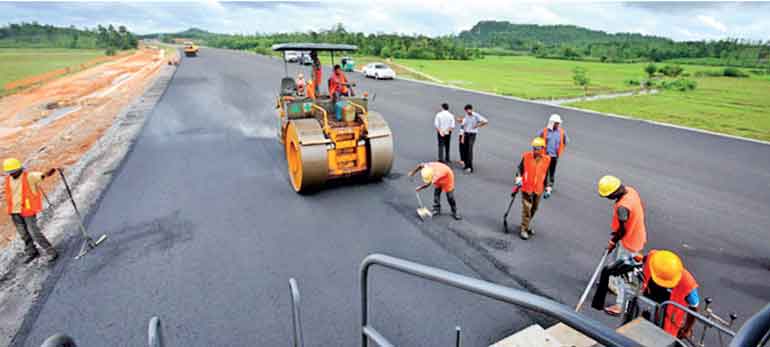Saturday Nov 22, 2025
Saturday Nov 22, 2025
Saturday, 25 January 2025 00:01 - - {{hitsCtrl.values.hits}}

Effective planning and resource utilisation are critical to minimising unnecessary disruptions
and maximising the efficiency of roadworks
One of the most significant challenges facing Sri Lanka’s road infrastructure system is the lack of coordination between the various stakeholders involved in roadwork projects. These stakeholders include local authorities, utility companies, contractors, and government bodies. Without a centralised coordinating authority, each entity works independently, often without communication or collaboration. This fragmented approach leads to inefficiency, redundant work, and significant delays
 The persistent issue of poorly managed roadworks in Sri Lanka has reached a critical juncture, becoming a glaring example of inefficiency and mismanagement in public infrastructure development. Across the country, roads are frequently excavated by various departments for essential work, such as laying pipelines, cables, or upgrading utilities. However, the aftermath of these activities is marked by long delays in restoration, substandard repairs, and a lack of accountability. These shortcomings collectively cause significant public inconvenience, financial waste, and safety hazards that impact millions of citizens daily.
The persistent issue of poorly managed roadworks in Sri Lanka has reached a critical juncture, becoming a glaring example of inefficiency and mismanagement in public infrastructure development. Across the country, roads are frequently excavated by various departments for essential work, such as laying pipelines, cables, or upgrading utilities. However, the aftermath of these activities is marked by long delays in restoration, substandard repairs, and a lack of accountability. These shortcomings collectively cause significant public inconvenience, financial waste, and safety hazards that impact millions of citizens daily.
The problem stems from a complex interplay of factors, including inadequate coordination among governmental agencies, poor enforcement of quality standards, and insufficient oversight mechanisms. The responsible entities, such as the Road Development Authority, Municipal Councils, Water and Drainage Board, electricity providers, and telecommunications companies, often operate in silos. This fragmented approach leads to repeated disruptions, with roads being excavated multiple times for different projects due to a lack of unified planning.
Furthermore, the financial implications of this inefficiency are severe. Public funds are squandered on repeated repairs, temporary fixes, and the administrative costs associated with mismanaged projects. Beyond the economic cost, the social toll is immense. Poorly restored roads endanger pedestrians, damage vehicles, and disrupt daily commutes, while unresolved issues exacerbate during the rainy season, amplifying risks and inconveniences.
This article examines the key issues plaguing road infrastructure management in Sri Lanka, offers a comprehensive analysis of their root causes, and proposes actionable solutions to ensure better governance, efficiency, and long-term sustainability of the nation’s road infrastructure.
Key issues in road infrastructure management
1.Lack of coordination and
governance gaps
One of the most significant challenges facing Sri Lanka’s road infrastructure system is the lack of coordination between the various stakeholders involved in roadwork projects. These stakeholders include local authorities, utility companies, contractors, and government bodies. Without a centralised coordinating authority, each entity works independently, often without communication or collaboration. This fragmented approach leads to inefficiency, redundant work, and significant delays.
Inconsistent project execution:
Road repairs and utility installations often overlap, leading to repeated disruptions. For instance, a road might be excavated for repairs only for another entity to come in later to lay utility lines in the same area. This redundancy wastes both time and resources, causing frustration among the public who are subjected to repeated road closures and diversions.
Resource mismanagement:
Political interference and the misallocation of resources further exacerbate the issue. Many times, projects are delayed or deferred due to political motivations. Resources are often diverted to politically favoured projects, leaving essential roadworks underfunded or ignored. This lack of focus on prioritising critical infrastructure projects not only delays development but also increases the overall cost of maintenance and repair in the long run.
Weak oversight and quality control:
Another issue related to governance is weak oversight. There is insufficient monitoring of contractors, leading to substandard work. Contractors may bypass quality standards to meet deadlines or cut costs, resulting in poor-quality repairs that need to be redone sooner than expected. The lack of effective supervision has also contributed to the culture of complacency, where officials and contractors are rarely held accountable for their inefficiencies.
2.Cultural and systemic issues
In addition to governance challenges, cultural and systemic factors play a significant role in the mismanagement of roadworks in Sri Lanka. These factors are deeply embedded in the country’s institutional and societal structures, affecting how projects are managed and executed.
Complacency and lack of accountability:
There is a general lack of accountability in the management of roadworks. Contractors are rarely penalised for delays, and officials are seldom held responsible for their failures to ensure that projects are completed on time and within budget. This lack of accountability creates a culture of complacency, where both public officials and contractors feel little pressure to meet performance expectations.
Political interference:
As with many sectors in Sri Lanka, political interference in road infrastructure management is widespread. Political agendas often influence the allocation of resources, with priority given to projects that align with short-term political goals rather than long-term national needs. This political interference undermines the integrity of the planning process, leading to misaligned priorities and inefficient resource use.
Limited public engagement:
Another issue is the limited public engagement in the planning and execution of road projects. Citizens are often excluded from the decision-making process, which leads to a lack of understanding of the importance of roadworks. Without proper engagement, the public may view road repairs as a source of inconvenience rather than a necessary step toward improving infrastructure. Additionally, this lack of transparency fuels frustration and resentment, which further hampers the successful implementation of projects.
Proposed solutions for reform
Addressing these systemic issues requires a comprehensive and multifaceted approach. Below are some potentially key solutions that can help overcome the challenges in Sri Lanka’s Road infrastructure management.
1.Establish a centralised coordination authority
A centralised body dedicated to overseeing roadworks across the country is essential to streamline the planning and execution of road projects. This body would coordinate the efforts of local authorities, utility companies, and contractors, ensuring that projects are synchronised and disruptions are minimised.
Key benefits:
For example, Singapore’s Land Transport Authority (LTA) has successfully implemented a centralised coordination model that minimises disruptions. By working closely with utility providers, the LTA ensures that roadworks and utility installations are carried out in a coordinated manner, reducing unnecessary overlaps and delays.
2.Implement strict timelines and penalties
To ensure that projects are completed on time and meet quality standards, strict timelines and penalties for non-compliance must be enforced. Performance-based contracts should be adopted, with clear deadlines for completion and penalties for contractors who fail to meet them.
Recommendations:
3.Ensure high-quality standards for repairs
High-quality repairs are essential to ensure that roads remain durable and do not require frequent repairs. Independent inspection teams should be established to monitor compliance with quality benchmarks. Contractors should be held financially responsible for any substandard work that fails to meet the required standards.
By setting clear quality standards and enforcing them rigorously, Sri Lanka can reduce the need for repeated repairs, thereby saving public funds and improving road safety.
4.Optimise resource utilisation
Effective planning and resource utilisation are critical to minimising unnecessary disruptions and maximising the efficiency of roadworks. Proper feasibility studies should be conducted before any work begins, ensuring that utility installations and road repairs are aligned in a single operation.
Proposed measures:
5.Enhance public transparency and engagement
Public engagement is key to improving the acceptance of roadworks. The Government should launch awareness campaigns to inform citizens about the timelines, objectives, and progress of ongoing projects. Citizens should also be provided with platforms to voice concerns, track progress, and receive updates on the status of roadworks.
Increased transparency would help reduce public frustration and foster a greater understanding of the need for infrastructure improvements.
6.Leverage technology for monitoring and oversight
Technology can play a crucial role in improving the oversight and accountability of road infrastructure management. Tools such as Geographic Information Systems (GIS), project management software, and drones can be used to monitor roadworks in real time, ensuring that projects stay on track and meet quality standards.
Technological tools:
7.Joint police and Grama Sevaka sign-off system
To ensure accountability and compliance, a joint sign-off system involving both police and Grama Sevaka officials can be implemented. This system would formalise the process of verifying completed roadworks and include but not limited to the following steps:
Completion notification: Once a project is completed, the contractor or project team notifies both the police and the Grama Sevaka for a final inspection.
Joint inspection:
Compliance checklist: A standardised checklist is used by both the Police and Grama Sevaka to document their findings. This checklist could cover but not be limited to the following:
Resolution of deficiencies: If any deficiencies are identified during the inspection, contractors are given a specific timeframe to rectify them. A follow-up inspection ensures compliance before final approval.
Final sign-off:
Once all requirements are met, both the police and the Grama Sevaka sign a Certificate of Completion, which acts as a formal record that the project has been inspected, approved, and meets compliance standards.
Record maintenance: Signed certificates and inspection reports are archived for future reference, ensuring transparency and accountability.
Benefits of a collaborative oversight framework
The introduction of a joint sign-off system provides several benefits:
Recommendations for implementation
By formalising the roles of police and Grama Sevaka officials in roadworks oversight and introducing a structured sign-off system, Sri Lanka can establish a robust framework for ensuring safety, compliance, and quality in infrastructure projects. This collaborative approach not only enhances accountability but also fosters trust between the authorities and the public, paving the way for sustainable development.
8.A citizen-driven monitoring platform: How it works
Authority dashboard: Real-time monitoring
Promoting transparency and accountability
Challenges and solutions
While the concept holds great promise, several challenges need to be addressed to ensure the platform’s success:
The benefits: A safer, more efficient roadwork system
In an age where technology enables greater citizen participation, a platform that allows the public to report roadwork issues can play a pivotal role in improving road safety and infrastructure. By empowering citizens, enhancing accountability, and providing authorities with real-time data, this solution can create safer streets for everyone. With the right approach, this platform can not only solve pressing roadwork-related problems but also create a sustainable, transparent, and collaborative approach to public infrastructure management.
Global best practices for road infrastructure management
Sri Lanka can learn valuable lessons from countries that have successfully managed their road infrastructure systems.
Conclusion: A vision for improved infrastructure in Sri Lanka
The challenges facing Sri Lanka’s road infrastructure are significant but not insurmountable. With a concerted effort that integrates centralised oversight, stringent quality standards, enhanced public engagement, and the active participation of key stakeholders, the nation can rebuild its road systems to support long-term economic growth and societal well-being. The inclusion of local authorities, such as the police and Grama Sevaka officials, in the oversight process will ensure compliance, accountability, and transparency in every project.
Furthermore, aligning these efforts with the President’s initiative for a cleaner and greener Sri Lanka underscores the commitment to sustainable development and environmental stewardship.
By adopting global best practices, leveraging technology, and fostering collaboration across sectors, Sri Lanka has the opportunity to transform its road infrastructure into a symbol of progress and resilience. Now is the time to act decisively and build a road network that not only meets today’s needs but also paves the way for a brighter, greener future.
(The author is a seasoned operations director, consultant, and writer, equipped with a diverse range of experience across fields such as
business management, education, consultancy, and journalism.)